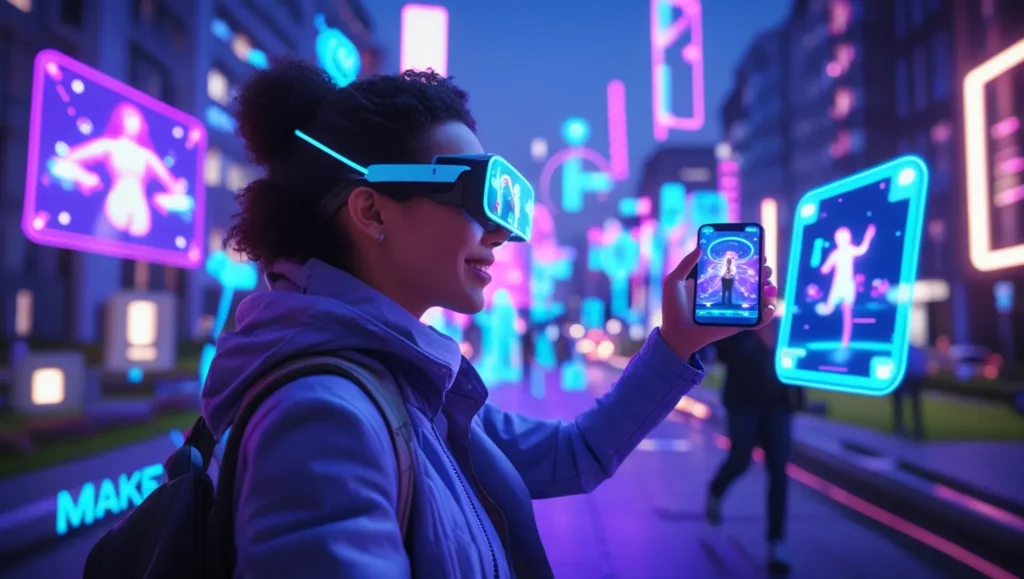
What Is Augmented Reality
In today’s evolving tech landscape, the Augmented Reality Framework plays a key role in creating digital experiences that interact with the physical world. Used in industries like education, healthcare, retail, and engineering, these frameworks provide the tools developers need for building interactive AR apps.
With features like real-time rendering, motion tracking, and object recognition, they power a new era of innovation. Developers use AR SDKs to create responsive and immersive environments on devices like smartphones, tablets, and Smartglasses. This article dives into the leading platforms, essential components, and upcoming trends that define the future of immersive technology across both consumer and enterprise spaces.
Augmented Reality Frameworks
To bring AR ideas to life, developers rely on tools called an Augmented Reality framework or AR SDKs (Software Development Kits). These are like toolboxes packed with code, APIs, and libraries that handle things like motion tracking, object detection, and scene rendering.
Without them, building Augmented Reality apps would be incredibly complex. Imagine trying to construct a skyscraper with only a hammer framework given you the blueprint, crane, and elevator too.
Platforms like ARKit for iOS or ARCore for Android simplify development and help ensure compatibility across different devices.
Three Solid Pillars of AR for Enterprise AR System
Think of an enterprise AR system as a three-legged stool made of content, hardware, and software.
Get one wrong, and the whole thing wobbles.
Whether it’s training workers, visualizing equipment, or improving field service, AR architects must blend these elements strategically. Tools exist today that are low-cost, scalable, and industry-proven.
Many businesses are already doing this with off-the-shelf smartphones, cloud databases, and lightweight AR apps.
1-Why AR Content Is the Fuel That Powers Immersive Experiences
Content is king even in an Augmented Reality Framework.
Whether it’s a 3D model of a car engine, a building floor plan, or a historical site, AR content turns experiences from “cool” to “compelling.” Enterprises today are sitting on mountains of data, from spreadsheets to massive cloud databases.
For example, utility companies use Augmented Reality to overlay underground pipelines on the ground via GPS and mapping metadata. Or a service technician scans a barcode and instantly sees a 3D breakdown of a part that needs repair.
That’s the magic of combining Big Data with AR.
2-Hardware in Augmented Reality
From Smartphones to Smartglasses and Beyond
AR hardware is what delivers those digital experiences to your eyes, ears, and even fingertips.
Right now, most AR experiences happen on smartphones and tablets because they’re widely available. But the future is leaning toward devices like Smartglasses and headsets that allow hands-free interaction, which is crucial in manufacturing, logistics, and healthcare.
These devices use sensors like GPS, gyroscopes, cameras, and LiDAR to understand your environment. Then they relay AR visuals, sound, or haptic feedback through speakers, screens, or vibration.
An AR technician fixing a machine in a noisy factory might “see” step-by-step instructions overlaid on the parts and never touch a manual.
3-Software in Augmented Reality Framework
Behind every AR interaction is powerful software making real-time decisions.
It starts with design software for building AR content, then moves into delivery software for publishing experiences over apps or web platforms. There’s also a lot going on behind the scenes: sensor data gets interpreted, user movement is tracked, and virtual elements are aligned with real-world positions.
For example, Unity or Unreal Engine lets developers create interactive 3D scenes. On top of that, enterprise platforms log user interactions, timestamp data, and adjust visuals on the fly.
Top 10 AR Platforms Redefining Reality in 2025
Here are the top AR platforms transforming how developers and companies build AR solutions:
As augmented reality platforms become the building blocks for immersive apps, it’s essential to understand which tools will lead the way in 2025. From mobile AR SDKs to cloud-powered enterprise solutions, these platforms enable developers to create seamless experiences that blend the digital and physical worlds.
Let’s explore the top 10 AR platforms that are redefining how we interact with reality:
1. Google ARCore
ARCore is Google’s flagship augmented reality development kit for Android, and now supports cross-platform AR experiences on iOS, Unity, and the web.
It brings powerful features like:
- Motion tracking using device sensors
- Environmental understanding through plane detection
- Light estimation to make virtual objects look realistic
ARCore is perfect for Android apps, retail demos, education, and real-world games. Developers also love its seamless integration with Google Maps and Geospatial API for location-based AR.
2. Meta Spark Studio (formerly Spark AR)
Meta Spark Studio is Meta’s AR platform for creating interactive filters and effects on platforms like Instagram and Facebook.
With drag-and-drop templates, target tracking, and visual scripting, it’s user-friendly even for non-developers. It supports:
- Face tracking
- 3D object rendering
- Audio and haptic integration
- Depth mapping and occlusion
It’s backed by a community of over 100,000 AR creators and is ideal for marketers, influencers, and small businesses looking to build branded AR experiences.
3. Apple’s RealityKit
RealityKit is Apple’s AR-first 3D framework for creating immersive experiences on iOS using ARKit.
Built for performance and realism, it enables:
- Physically-based rendering (realistic shadows, reflections)
- Motion blur, camera noise, and grounding shadows
- Easy integration with SwiftUI and SceneKit
With the launch of Apple Vision Pro, RealityKit has gained new power in spatial computing, ideal for developers working on apps for mixed reality headsets and iPhones alike.
4. NVIDIA CloudXR
NVIDIA’s CloudXR platform streams high-fidelity VR and AR experiences over 5G and Wi-Fi.
Powered by RTX GPUs and Virtual Workstations (vWS), it allows:
- Real-time rendering of complex AR content from the cloud
- Streaming to untethered devices (smartphones, headsets)
- Low-latency, ultra-responsive XR experiences
It’s built for enterprise applications, architectural visualisation, training simulations, and cloud-powered AR projects.
5. Unity AR Foundation
Unity AR Foundation is a cross-platform development toolkit that connects with both ARKit and ARCore. Developers can write one set of code and deploy it on iOS and Android simultaneously.
Key strengths:
- Marker-based and Markerless tracking
- SLAM (Simultaneous Localisation and Mapping)
- AR plane detection, face tracking, and image recognition
- Strong integration with Unity’s 3D engine
Unity is widely used in gaming, automotive, training, and industrial applications thanks to its scalability and performance.
6. Wikitude
Wikitude is known for its location-based AR capabilities, making it great for tourism, navigation, and innovative city applications.
It supports:
- Image and object recognition
- Geo AR (AR triggered by location)
- Instant tracking (SLAM)
- Integration with smart glasses (like Epson, Vuzix)
Recently acquired by Qualcomm, Wikitude continues to power AR across 180+ countries, supporting iOS, Android, and wearable devices.
7. Adobe Aero
Adobe Aero brings AR design to creative professionals, no coding required.
It allows:
- Drag-and-drop 3D model placement
- Animation triggers and interactive behaviour
- Seamless integration with Photoshop, Illustrator, and Substance 3D
Aero is great for storytelling, product visualisation, and AR marketing. It’s free to use and ideal for designers experimenting with mobile AR.
8. ARToolKit
ARToolKit is an open-source AR SDK that’s been around for over two decades.
Best known for:
- Marker-based tracking
- Camera calibration
- Integration with 3D rendering engines
Now maintained by the artoolkitX community, it’s perfect for researchers, students, and indie developers looking to experiment with AR algorithms.
9. Niantic Lightship
Famous for building Pokémon GO, Niantic’s Lightship platform provides tools to develop real-world AR games and experiences.
Core features include:
- Real-time meshing
- Multiplayer AR
- Occlusion handling
- Shared world mapping
With a mission to build the “real-world metaverse,” Niantic supports developers building location-based AR apps that bring people together physically and socially.
10. Sketchfab
Sketchfab is a 3D model repository used by developers and artists to find or publish AR/VR content.
Highlights:
- 5 million+ models available
- WebGL-based viewer
- Supports WebXR, mobile browsers, and VR headsets
- Marketplace for buying/selling AR-ready assets
It’s often used alongside Unity or Unreal Engine to enhance AR projects with rich visual assets without needing to model from scratch.
Smart Difference between Platforms
Apple’s RealityKit vs Google ARCore: Who’s Winning the Mobile AR War?
Apple’s RealityKit is optimised for iOS devices, offering seamless blending of AR content with realistic shadows, reflections, and movement. It’s excellent for polished, premium apps.
Google’s ARCore, meanwhile, brings similar capabilities to Android devices, with features like motion tracking, environmental understanding, and light estimation.
For developers building cross-platform apps, understanding these tools is key. Use Unity AR Foundation to build once and deploy across both.
Unity AR Foundation and Vuforia
When you want to build AR apps that work on both iOS and Android, Unity AR Foundation is your go-to framework. It bridges ARKit and ARCore, letting you write one codebase and deploy everywhere.
Then there’s Vuforia, ideal for marker-based AR like scanning logos or images. It supports object recognition, cloud databases, and even ground plane detection for placing AR on flat surfaces.
Businesses often pair Unity + Vuforia for interactive marketing, industrial training, and product demos.
Rising Stars and Open Source Heroes: Wikitude, EasyAR, and ARToolKit
While big players dominate the scene, these underdogs are carving unique paths:
- Wikitude supports Smartglasses, geolocation, and SLAM-based tracking
- EasyAR is developer-friendly, offering 3D object tracking and cloud recognition
- ARToolKit is open-source and used widely in academia and custom apps
If you’re building experimental or budget-conscious AR projects, these platforms are worth exploring.
Advanced Uses of an Augmented Reality Framework

Two incredible things AR can do:
Occlusion Management
Imagine a Pokémon hiding behind a real tree. That’s occlusion, and it’s possible using 3D models or real-time mesh capture to detect obstacles and place AR accordingly.
⚙️ Physics Interactions
Want a virtual ball to bounce off your real desk? AR systems use physics engines and depth sensing to make that happen, capturing real-time meshes and syncing them with gravity, collision, and surface detection.
These features are game-changers for AR gaming, industrial simulation, and training scenarios.
Augmented Reality Framework: A Developer’s Guide
Here’s your step-by-step guide to selecting the best AR framework:
- Define your project – Is it for Android, iOS, or both?
- List required features – SLAM, occlusion, 3D object tracking, cloud sync?
- Check device compatibility – Will it run on smartphones, tablets, or Smartglasses?
- Consider licensing & cost – Some are free, others charge per seat or app
- Evaluate community support – Look for forums, docs, and sample projects
- Think long-term – Choose a framework that scales with your vision
Future of Augmented Reality Framework: Where Reality and AI Converge
AR is growing fast, and its future is tightly tied to AI, 5G, and cloud computing.
Imagine persistent AR where a digital object stays in place even after you close the app, or collaborative AR where multiple users interact with the same virtual object in real time.
Future trends include:
- AI-powered scene recognition
- Cloud rendering and edge computing
- Cross-platform standardization
- Better privacy and ethics controls
- Deeper hardware integration
The future is immersive, intelligent, and borderless.
Conclusion
Augmented Reality frameworks are shaping the future of digital interaction, quietly powering the tools and experiences that redefine how we see and engage with the world. From interactive medical training to immersive shopping and real-time industrial support, AR is becoming a core technology across industries.
Frameworks like ARKit, ARCore, Unity AR Foundation, and others equip developers with the power to create smart, seamless, and engaging experiences. But success in AR doesn’t rely on software alone; it thrives at the intersection of content, hardware, and responsive software working together.
With advancements in AI, cloud rendering, and 5G connectivity, the next generation of AR applications will be smarter, faster, and more connected than ever before. Whether you’re building for enterprise or entertainment, this is your moment to explore, innovate, and lead.
FAQs:
What are the five types of augmented reality?
The five main types of augmented reality (AR) are:
- Marker-based AR – Uses visual markers like QR codes or images to trigger digital content.
- Markerless AR – Also known as location-based AR, uses GPS, accelerometers, and compass data.
- Projection-based AR – Projects light onto physical surfaces and senses interaction through touch or motion.
- Superimposition-based AR – Replaces the original view with an augmented version (e.g., replacing engine parts with digital overlays).
- SLAM (Simultaneous Localisation and Mapping) AR – Maps environments in real time to place virtual objects accurately.
What are the four types of AR?
In most educational contexts, AR is categorised into four broad types:
- Marker-based AR
- Markerless AR
- Projection AR
- Superimposition AR
These classifications help developers choose the right AR experience design based on the use case.
What is the best software for AR?
The best augmented reality software depends on your project needs, but here are the top choices:
- Unity with AR Foundation – Best for cross-platform development
- ARKit (iOS) and ARCore (Android) – For native mobile AR apps
- Vuforia – Ideal for marker-based AR and enterprise solutions
- Adobe Aero – No-code platform perfect for designers
- Meta Spark Studio – Great for creating AR filters on social media
Each platform offers unique features, such as SLAM tracking, object recognition, or cloud-based AR.
What are the three elements of augmented reality?
Every AR system is built on three essential elements:
- Content – The digital data or 3D models you want to display
- Hardware – Devices like smartphones, tablets, or Smartglasses
- Software – Frameworks and applications that process sensor data and render AR visuals
Together, they form the foundation of enterprise AR solutions and consumer apps alike.
What is an AR tool?
An AR tool is a software development kit (SDK) or platform that developers use to build augmented reality experiences. Examples include:
- ARKit, ARCore
- Unity AR Foundation
- ARToolKit
- Vuforia
These tools offer APIs for environment tracking, 3D rendering, and interaction design, enabling developers to create engaging and interactive AR apps.
What are some examples of augmented reality?
Real-world examples of augmented reality include:
- Pokémon GO – Mobile game overlaying characters on real-world locations
- IKEA Place – Visualise furniture in your room using AR
- Google Lens – Identifies objects and translates text in real time
- AR anatomy learning tools – Used in medical schools
- Snapchat filters – Add real-time visual effects to selfies
AR is used in gaming, retail, healthcare, education, and even industrial training.
Which is the most frequently chosen augmented reality device?
Currently, smartphones are the most widely used AR devices, thanks to their availability and built-in sensors. However, Smartglasses like Microsoft HoloLens or Magic Leap are gaining traction, especially in enterprise AR use cases.
Why would anyone need an AR?
People and businesses use AR technology to:
- Visualise products before buying (e.g., furniture or makeup)
- Train employees in complex environments
- Educate students with immersive content
- Enhance customer experience
- Enable remote assistance in the field
- Create engaging marketing experiences
An augmented reality Framework helps make information more interactive, visual, and memorable.
Is AR Foundation a framework?
Yes, AR Foundation is a cross-platform AR framework developed by Unity. It allows developers to write AR apps that work on both iOS (ARKit) and Android (ARCore) using a single codebase.
It supports features like image tracking, plane detection, SLAM, and 3D object interaction.
What are AR models used for?
AR models are 3D digital representations used in AR apps to:
- Visualise complex machinery in training apps
- Display products in e-commerce
- Simulate anatomy in healthcare
- Guide users in maintenance or repair tasks
- Animate characters in AR games
These models bring AR experiences to life by interacting with the real world.
What is an example of AR learning?
A great example is the Merge Cube, a physical cube that comes to life with AR apps. Students can explore solar systems, human organs, and geometric shapes in 3D.
Other AR learning tools include zSpace, Google Expeditions, and CoSpaces Edu, which let learners build and interact with virtual content.
What algorithms are used in AR?
AR systems rely on several powerful algorithms, such as:
- SLAM (Simultaneous Localisation and Mapping) – For environment tracking
- Feature Detection – Identifies points of interest in the camera feed
- Pose Estimation – Determines the device’s position and orientation
- Object Recognition – Recognises predefined markers or 3D objects
- Depth Sensing – Calculates the distance between objects and the camera
- Occlusion Handling – Ensures virtual objects appear behind real ones when necessary
These algorithms help create stable, accurate, and immersive AR experiences.


